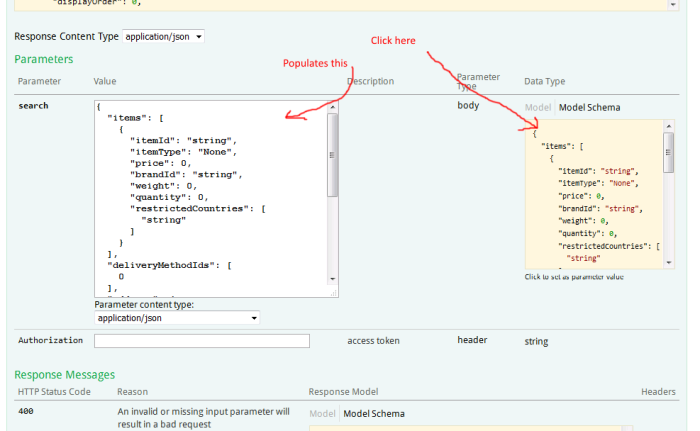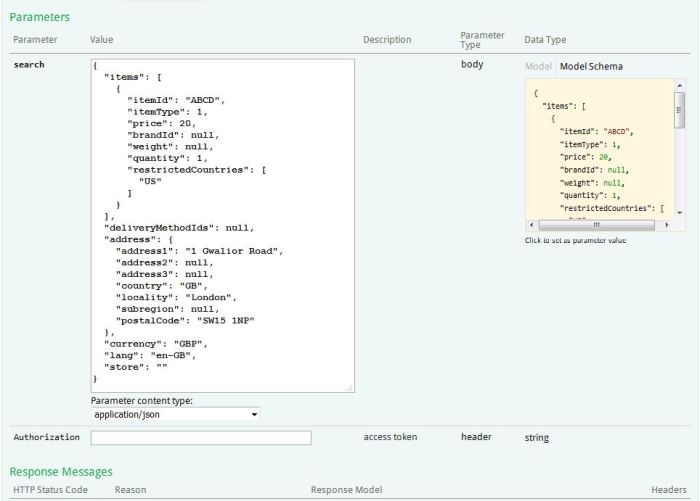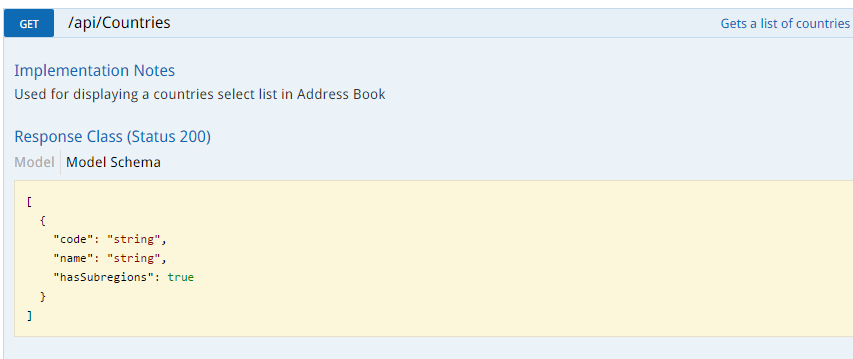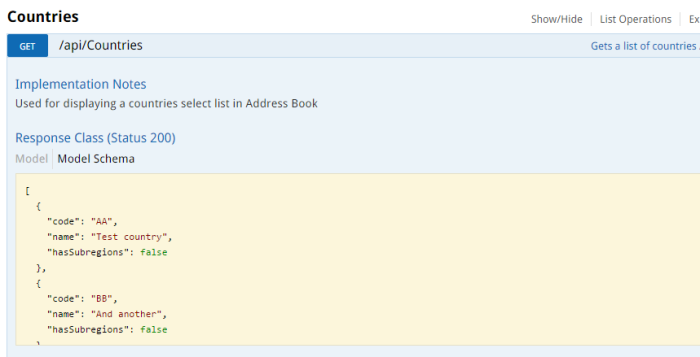| 📣 Rename to Swashbuckle.AspNetCore.Filters |
|---|
| This project was formerly called Swashbuckle.AspNetCore.Examples, but it has grown from there to become a grab-bag of various filters I have created (or copied) since I started used Swashbuckle in 2015. So I have renamed it. |
This library contains a bunch of filters for Swashbuckle.AspNetCore.
- Add example requests https://mattfrear.com/2016/01/25/generating-swagger-example-requests-with-swashbuckle/
- Add example responses https://mattfrear.com/2015/04/21/generating-swagger-example-responses-with-swashbuckle/
- Add comments for request and response properties
- Add security info to each operation that has an
[Authorize]endpoint, allowing you to send OAuth2 bearer tokens via Swagger-UI https://mattfrear.com/2018/07/21/add-an-authorization-header-to-your-swagger-ui-with-swashbuckle-revisited/ - Add a file upload button https://mattfrear.com/2018/01/02/add-an-upload-button-to-your-swagger-page/
- Add any old request header to all requests
- Add any old response header to all responses
- Add an indicator to each endpoint to show if it has an
[Authorize]header (and for which policies and roles)
- Where to get it
- What's included
- Installation
- How to use
- Pascal case or Camel case?
- Render Enums as strings
- Advanced: Examples with Dependency injection
From NuGet.
| Version of Swashbuckle you're using | You'll want this version of this package |
|---|---|
| Swashbuckle 1.0 - 5.5 | https://www.nuget.org/packages/Swashbuckle.Examples/ |
| Swashbuckle.AspNetCore version 1.0.0 - 2.5.0 | https://www.nuget.org/packages/Swashbuckle.AspNetCore.Examples/ |
| Swashbuckle.AspNetCore version 3.0.0 | https://www.nuget.org/packages/Swashbuckle.AspNetCore.Filters/ |
| Swashbuckle.AspNetCore version 4.0.0 and above | https://www.nuget.org/packages/Swashbuckle.AspNetCore.Filters/ Version >= 4.5.1 |
Populate swagger's definitions.YourObject.example with whatever object you like.
This is great for manually testing and demoing your API as it will prepopulate the request with some useful data, so that when you click the example request in order to populate the form, instead of getting an autogenerated request like this:
You’ll get your desired example, with useful valid data, like this:
You can see the example output in the underlying swagger.json file, which you can get to by starting your solution and navigating to swagger/v1/swagger.json
Allows you to add custom data to the example response shown in Swagger. So instead of seeing the default boring data like so:
You'll see some more realistic data (or whatever you want):
Adds security information to each operation so that you can send an Authorization header to your API. Useful for API endpoints that have JWT token authentication. e.g.
Adds a button for uploading a file via IFormFile

Adds any string to your request headers for all requests. I use this for adding a correlationId to all requests.
Allows you to specify response headers for any operation

If you use the [Authorize] attribute to your controller or to any actions, then (Auth) is added to the action's summary,
along with any specified policies or roles.
-
Install the NuGet package
-
In the ConfigureServices method of Startup.cs, inside your
AddSwaggerGencall, enable whichever filters you need
// This method gets called by the runtime. Use this method to add services to the container.
public void ConfigureServices(IServiceCollection services)
{
// Add framework services.
services.AddMvc();
services.AddSwaggerGen(c =>
{
c.SwaggerDoc("v1", new Info { Title = "My API", Version = "v1" });
// [SwaggerRequestExample] & [SwaggerResponseExample]
// version < 3.0 like this: c.OperationFilter<ExamplesOperationFilter>();
// version 3.0 like this: c.AddSwaggerExamples(services.BuildServiceProvider());
// version 4.0 like this:
c.ExampleFilters();
c.OperationFilter<AddFileParamTypesOperationFilter>(); // Adds an Upload button to endpoints which have [AddSwaggerFileUploadButton]
c.OperationFilter<AddHeaderOperationFilter>("correlationId", "Correlation Id for the request", false); // adds any string you like to the request headers - in this case, a correlation id
c.OperationFilter<AddResponseHeadersFilter>(); // [SwaggerResponseHeader]
var filePath = Path.Combine(AppContext.BaseDirectory, "WebApi.xml");
c.IncludeXmlComments(filePath); // standard Swashbuckle functionality, this needs to be before c.OperationFilter<AppendAuthorizeToSummaryOperationFilter>()
c.OperationFilter<AppendAuthorizeToSummaryOperationFilter>(); // Adds "(Auth)" to the summary so that you can see which endpoints have Authorization
// or use the generic method, e.g. c.OperationFilter<AppendAuthorizeToSummaryOperationFilter<MyCustomAttribute>>();
// add Security information to each operation for OAuth2
c.OperationFilter<SecurityRequirementsOperationFilter>();
// or use the generic method, e.g. c.OperationFilter<SecurityRequirementsOperationFilter<MyCustomAttribute>>();
// if you're using the SecurityRequirementsOperationFilter, you also need to tell Swashbuckle you're using OAuth2
c.AddSecurityDefinition("oauth2", new ApiKeyScheme
{
Description = "Standard Authorization header using the Bearer scheme. Example: \"bearer {token}\"",
In = "header",
Name = "Authorization",
Type = "apiKey"
});
});
}- If you want to use the Request and Response example filters (and have called
c.ExampleFilters()above), then you MUST also call either
services.AddSwaggerExamplesFromAssemblyOf<MyExample>();This will register your examples with ServiceProvider, which is needed for Automatic annotation. Or, if you don't want to register them, say if you're doing Manual annotation, then you should call
services.AddSwaggerExamples(); AddSwaggerExamplesFromAssemblyOf<T> is the recommended option.
Version 4.0 supports automatic annotation. To use this, you MUST call services.AddSwaggerExamplesFromAssemblyOf<MyExample>(); (and c.ExampleFilters();) as shown in the Installation instructions above.
Let's say you have a controller action which takes some input from the body, in this case a DeliveryOptionsSearchModel:
[HttpPost]
public async Task<IHttpActionResult> DeliveryOptionsForAddress([FromBody]DeliveryOptionsSearchModel search)Then all you need to do is implement IExamplesProvider<DeliveryOptionsSearchModel>:
public class DeliveryOptionsSearchModelExample : IExamplesProvider<DeliveryOptionsSearchModel>
{
public DeliveryOptionsSearchModel GetExamples()
{
return new DeliveryOptionsSearchModel
{
Lang = "en-GB",
Currency = "GBP",
Address = new AddressModel
{
Address1 = "1 Gwalior Road",
Locality = "London",
Country = "GB",
PostalCode = "SW15 1NP"
}
};
}And that's it.
Alternatively, if you want to be more explicit, you can use the SwaggerRequestExample attribute. This is how it was done in versions 1.0 - 3.0. Any manual annotations will override automatic annotations.
Decorate your controller methods with the included SwaggerRequestExample attribute:
[HttpPost]
[SwaggerRequestExample(typeof(DeliveryOptionsSearchModel), typeof(DeliveryOptionsSearchModelExample))]
public async Task<IHttpActionResult> DeliveryOptionsForAddress([FromBody]DeliveryOptionsSearchModel search)Now implement a IExamplesProvider, in this case via a DeliveryOptionsSearchModelExample which will generate the example data. It should return the type you specified when you specified the [SwaggerRequestExample].
public class DeliveryOptionsSearchModelExample : IExamplesProvider
{
public object GetExamples()
{
return new DeliveryOptionsSearchModel
{
Lang = "en-GB",
Currency = "GBP",
Address = new AddressModel
{
Address1 = "1 Gwalior Road",
Locality = "London",
Country = "GB",
PostalCode = "SW15 1NP"
},
Items = new[]
{
new ItemModel
{
ItemId = "ABCD",
ItemType = ItemType.Product,
Price = 20,
Quantity = 1,
RestrictedCountries = new[] { "US" }
}
}
};
}In the Swagger document, this will populate the request's schema object example property. The spec for this says:
| Field Name | Type | Description |
|---|---|---|
| example | Any | A free-form property to include an example of an instance for this schema. |
As of version 2.4, List<T> request examples are supported. For any List<T> in the request, you may define a SwaggerRequestExample for T.
Your IExamplesProvider should only return a single T and not a List<T>.
Working example:
[SwaggerRequestExample(typeof(PeopleRequest), typeof(ListPeopleRequestExample), jsonConverter: typeof(StringEnumConverter))]
public IEnumerable<PersonResponse> GetPersonList([FromBody]List<PeopleRequest> peopleRequest)
{
// and then:
public class ListPeopleRequestExample : IExamplesProvider
{
public object GetExamples()
{
return new PeopleRequest { Title = Title.Mr, Age = 24, FirstName = "Dave in a list", Income = null };
}
}Version 4.0 supports automatic annotation. To use this, you MUST call services.AddSwaggerExamplesFromAssemblyOf<MyExample>() (and c.ExampleFilters()) as shown in the Installation instructions above.
If it's obvious which type your action returns, then no ProducesResponseType or SwaggerResponse attributes need to be specified, e.g.
public async Task<ActionResult<IEnumerable<Country>>> Get(string lang)
// or public ActionResult<IEnumerable<Country>> Get(string lang)
// or public IEnumerable<Country> Get(string lang)Or, you can optionally decorate your methods (or controller) with either the ProducesResponseType or the SwaggerResponse attribute:
[SwaggerResponse(200, "The list of countries", typeof(IEnumerable<Country>))]
// or, like this [ProducesResponseType(typeof(IEnumerable<Country>), 200)]
[SwaggerResponse(400, type: typeof(IEnumerable<ErrorResource>))]
public async Task<HttpResponseMessage> Get(string lang)Now you’ll need to add an Examples class, which will implement IExamplesProvider<T> to generate the example data for the Response:
public class CountryExamples : IExamplesProvider<IEnumerable<Country>>
{
public IEnumerable<Country> GetExamples()
{
return new List<Country>
{
new Country { Code = "AA", Name = "Test Country" },
new Country { Code = "BB", Name = "And another" }
};
}
}Alternatively, if you want to be more explicit, you can use the SwaggerResponseExample attribute. This is how it was done in versions 1.0 - 3.0. Any manual annotations will override automatic annotations.
Decorate your methods with the new SwaggerResponseExample attribute:
[SwaggerResponse(200, "The list of countries", typeof(IEnumerable<Country>))]
// or, like this [ProducesResponseType(typeof(IEnumerable<Country>), 200)]
[SwaggerResponseExample(200, typeof(CountryExamples))]
[SwaggerResponse(400, type: typeof(IEnumerable<ErrorResource>))]
public async Task<HttpResponseMessage> Get(string lang)For manual annotation implement IExamplesProvider to generate the example data
public class CountryExamples : IExamplesProvider
{
public object GetExamples()
{
return new List<Country>
{
new Country { Code = "AA", Name = "Test Country" },
new Country { Code = "BB", Name = "And another" }
};
}
}In the Swagger document, this will populate the response's example object. The spec for this says:
| Field Pattern | Type | Description |
|---|---|---|
| {mime type} | Any | The name of the property MUST be one of the Operation produces values (either implicit or inherited). The value SHOULD be an example of what such a response would look like. |
Example response for application/json mimetype of a Pet data type:
{
"application/json": {
"name": "Puma",
"type": "Dog",
"color": "Black",
"gender": "Female",
"breed": "Mixed"
}
}Note that this differs from the Request example in that the mime type is a required property on the response example but not so on the request example.
- Request examples are not shown for querystring parameters (i.e. HTTP GET requests, or for querystring parameters for POST, PUT etc methods). Request examples will only be shown in request body. This is a limitation of the Swagger 2.0 spec https://github.com/OAI/OpenAPI-Specification/blob/master/versions/2.0.md#parameterObject.
- For requests, in the Swagger 2.0 spec there is only one schema for each request object defined across all the API endpoints. So if you are using the same request object in multiple API endpoints, i.e. on multiple controller actions like this:
DeliveryOptions.cs
public async Task<IHttpActionResult> DeliveryOptionsForAddress(DeliveryOptionsSearchModel search)
...
// maybe in some other controller, e.g. Search.cs
public async Task<IHttpActionResult> Search(DeliveryOptionsSearchModel search)That DeliveryOptionsSearchModel object is only defined once in the entire Swagger document and it can only have one request example defined.
First you need to already have OAuth2 configured correctly, and some of your controllers and actions locked down with the [Authorize] attribute.
Then you need to tell Swagger that you're using OAuth2, as shown in the Installation section above:
services.AddSwaggerGen(c =>
{
c.AddSecurityDefinition("oauth2", new ApiKeyScheme
{
Description = "Standard Authorization header using the Bearer scheme. Example: \"bearer {token}\"",
In = "header",
Name = "Authorization",
Type = "apiKey"
});This adds a securityDefinition to the bottom of the Swagger document, which Swagger-UI renders as an "Authorize" button, which when clicked brings up the Authorize dialog box shown above.
Then, when you enable the SecurityRequirementsOperationFilter:
// add Security information to each operation for OAuth2
c.OperationFilter<SecurityRequirementsOperationFilter>();It adds a security property to each operation, which renders in Swagger-UI as a padlock next to the operation:
By default, the SecurityRequirementsOperationFilter also adds 401 and 403 to each operation that has [Authorize] on it:
If you don't want to do that you can pass false when you configure it:
c.OperationFilter<SecurityRequirementsOperationFilter>(false);N.B. Swashbuckle.AspNetCore 4.0 supports IFormFile directly, so this filter is no longer needed.
Add the [AddSwaggerFileUploadButton] attribute to any controller actions which takes an IFormFile, e.g.
[AddSwaggerFileUploadButton]
[HttpPost("upload")]
public IActionResult UploadFile(IFormFile file)
{When you enable the filter in your Startup.cs, as per the Installation section above, you can specify the name (string)
and description (string) of the new header parameter, as well as whether it is required or not (bool).
This will add the input box to every controller action.
Specify one or more [SwaggerResponseHeader] attributes on your controller action, like so:
[SwaggerResponseHeader(HttpStatusCode.OK, "Location", "string", "Location of the newly created resource")]
[SwaggerResponseHeader(HttpStatusCode.OK, "ETag", "string", "An ETag of the resource")]
public IHttpActionResult GetPerson(PersonRequest personRequest)
{Specify [Authorization] headers on either a Controller:
[Authorize]
public class ValuesController : Controlleror on an action:
[Authorize("Customer")]
public PersonResponse GetPerson([FromBody]PersonRequest personRequest)You can optionally specify policies [Authorize("Customer")] or roles [Authorize(Roles = "Customer")] and they will be added to the Summary too.
The default is camelCase. If you want PascalCase you can pass in a DefaultContractResolver like so:
[SwaggerResponseExample(200, typeof(PersonResponseExample), typeof(DefaultContractResolver))]
By default enums will output their integer values. If you want to output strings you can pass in a StringEnumConverter like so:
[SwaggerResponseExample(200, typeof(PersonResponseExample), jsonConverter: typeof(StringEnumConverter))]
If for some reason you need to have examples with DI (for example, to read them from a database), you can use constructor injection:
internal class PersonRequestExample : IExamplesProvider
{
private readonly IHostingEnvironment _env;
public PersonRequestExample(IHostingEnvironment env)
{
_env = env;
}
public object GetExamples()
{
return new PersonRequest { Age = 24, FirstName = _env.IsDevelopment() ? "Development" : "Production", Income = null };
}
}Then, you should register the Swagger examples via the FromAssemblyOf<T> extension method.
services.AddSwaggerExamplesFromAssemblyOf<PersonRequestExample>();If you are using services.AddSwaggerExamples(), then you would have to manually register your IExamplesProvider class:
services.AddSingleton<PersonRequestExample>();The FromAssemblyOf<T> extension method is the recommended approach.











